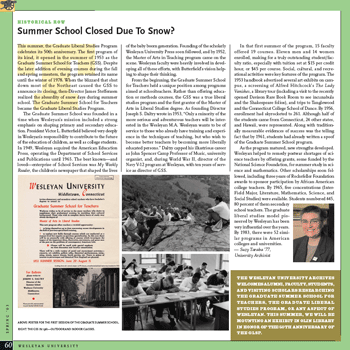HISTORICAL ROW: SUMMER SCHOOL CLOSED DUE TO SNOW
 This summer, the Graduate Liberal Studies Program celebrates its 50th anniversary. The first program of its kind, it opened in the summer of 1953 as the Graduate Summer School for Teachers (GSS). Despite the later addition of evening courses during the fall and spring semesters, the program retained its name until the winter of 1978. When the blizzard that shut down most of the Northeast caused the GSS to announce its closing, then-Director James Steffensen realized the absurdity of snow days during summer school. The Graduate Summer School for Teachers became the Graduate Liberal Studies Program.
This summer, the Graduate Liberal Studies Program celebrates its 50th anniversary. The first program of its kind, it opened in the summer of 1953 as the Graduate Summer School for Teachers (GSS). Despite the later addition of evening courses during the fall and spring semesters, the program retained its name until the winter of 1978. When the blizzard that shut down most of the Northeast caused the GSS to announce its closing, then-Director James Steffensen realized the absurdity of snow days during summer school. The Graduate Summer School for Teachers became the Graduate Liberal Studies Program.
The Graduate Summer School was founded in a time when Wesleyan’s mission included a strong emphasis on shaping primary and secondary education. President Victor L. Butterfield believed very deeply in Wesleyan’s responsibility to contribute to the future of the education of children, as well as college students. In 1949, Wesleyan acquired the American Education Press, operating the Department of School Services and Publications until 1965. The best known—and loved—enterprise of School Services was My Weekly Reader, the children’s newspaper that shaped the lives of the baby boom generation. Founding of the scholarly Wesleyan University Press soon followed, and by 1952, the Master of Arts in Teaching program came on the scene. Wesleyan faculty were heavily involved in developing all of these efforts, with Butterfield’s vision helping to shape their thinking.
From the beginning, the Graduate Summer School for Teachers held a unique position among programs aimed at schoolteachers. Rather than offering education or methods courses, the GSS was a true liberal studies program and the first grantor of the Master of Arts in Liberal Studies degree. As founding Director Joseph S. Daltry wrote in 1953, “Only a minority of the more serious and adventurous teachers will be interested in the Wesleyan M.A. Wesleyan wants to be of service to those who already have training and experience in the techniques of teaching, but who wish to become better teachers by becoming more liberally educated persons.” Daltry capped his illustrious career as John Spencer Camp Professor of Music, university organist, and, during World War II, director of the Navy V-12 program at Wesleyan, with ten years of service as director of GSS.
In that first summer of the program, 15 faculty offered 19 courses. Eleven men and 14 women enrolled, making for a truly outstanding student/faculty ratio, especially with tuition set at $15 per credit hour, or $45 per course. Social, cultural, and recreational activities were key features of the program. The 1953 handbook advertised several art exhibits on campus, a screening of Alfred Hitchcock’s The Lady Vanishes, a library tour (including a visit to the recently opened Davison Rare Book Room to see incunabula and the Shakespeare folios), and trips to Tanglewood and the Connecticut College School of Dance. By 1956, enrollment had skyrocketed to 261. Although half of the students came from Connecticut, 24 other states, and Hawaii, were represented. Along with traditionally measurable evidences of success was the telling fact that by 1961, students had already written a spoof of the Graduate Summer School program.
As the program matured, new strengths developed. Wesleyan helped to remedy postwar shortages of science teachers by offering grants, some funded by the National Science Foundation, for summer study in science and mathematics. Other scholarships soon followed, including three years of Rockefeller Foundation awards to sponsor participation by African American college teachers. By 1965, five concentrations (Inter-Field Major, Literature, Mathematics, Science, and Social Studies) were available. Students numbered 445, 80 percent of them secondary school teachers. The graduate liberal studies model pioneered by Wesleyan has been very influential over the years. By 1983, there were 52 similar programs in American colleges and universities.
— Suzy Taraba ’77,
University Archivist
